Retesting the ASUS Rampage IV Black Edition Audio and the Pitfalls of Audio Testing
by Ian Cutress on January 31, 2014 4:45 AM EST- Posted in
- Motherboards
- Asus
- Audio
- Audio Precision

In the motherboard section of AnandTech, we rarely touched the audio section of the motherboard until fairly recently. Audio is a delicate issue, and knowledge on the subject falls into a wide range from the tone deaf all the way to the hyper enthusiast. Professional and prosumer audio equipment can be honed to perfection and cost an appropriate amount, where discussion on quality over $10k per meter cables can happen. It is very hard to quantify an audio experience into a single set of rules, but as the motherboard arena can feature rather elaborate audio setups designed to enhance the quality or provide sufficient electrical filtering, and that these can be some of the major selling points, several of our readers asked us to start testing the audio.
To put this into perspective, a motherboard manufacturer can create an audio portion of the motherboard that costs $2 to buy and implement. Another manufacturer will spend $20 to get a better audio codec and DAC, better audio filters, headphone amplifiers, and specifically separate the digital and audio traces on the motherboard as to reduce potential sources of interference, as well as focusing on a single output to achieve all this. Part of testing these scenarios is producing such a test that a reader can relate to, as well as a series of numbers for comparison to put in the review – both manufacturers and readers want to see that their hard earned engineering money and effort went into something that can be compared.
In light of this request to test audio, looking into the best way to test it is a minefield. The correct equipment in order to get an accurate test of dynamic range, noise and distortion costs over $10k – for example, the audio equipment used in Chris Heinonen’s recent foray into smartphone audio testing was an Audio Precision APx582, which starts at eleven thousand. Audio Precision is often cited as the company that all audio manufacturers go to in order to test their hardware. Unfortunately unlike Chris I am not able to source Audio Precision testing equipment due to my location and contacts, but having the hardware on hand takes everything out of the equation except the audio generator and filtering pathway that a manufacturer decides to use.
One ‘quick and easy’ test that has been in the mix and in several press pack guides is Rightmark: Audio Analyzer (RM:AA). This is a software solution to what is ultimately a hardware problem, and relies on the same hardware doing both the signal production and the signal receiving. This causes a number of issues, such as channel leakage, harmonic resonance in adjacent signals and that the limiting factor of the hardware being testing might affect other parts of the test. More often than not it is also difficult to compare results between products, due to input levels and driver settings. In order to provide accurate and comparable results, the software has to be explicitly set up for consistency and comparison, something a lot of reviewers that use RM:AA do not do.
I must confess that for a while I was in this crowd. My RM:AA test was ultimately out of the box and produced wildly conflicting results. When audio solutions were quoted as 108 dB for signal-to-noise ratio were getting 92 dB, the conclusions were along the lines of differences in signaling and manufacture of the motherboard. In reality, the test was very wrong – the OS by default limits input/output to 16-bit + 44.1 kHz, producing an artificial ceiling, and the volume ratio of output/input in the testing loop was not standardized. While I kept the input/output the same, in fact each output of the audio jacks can have different responses to the audio in question.
After delving further into the topic, we standardized the RM:AA test at AnandTech. The OS is now set to 24-bit, 192 kHz input and output (or the highest possible based on the audio codec options), the output volume was set to 100% and the input volume adjusted to provide accurate results without over-distorting the input. Ultimately our testing is still limited to the level of the input on the codec, often cited around 104 dB SNR compared to a 108 dB or 112 dB peak output, depending on what audio codec + DAC are used. Even when the same 3.5mm shielded cable is used or different tests, cable losses in a uncontrolled environment can be excessive (1-2 dB SNR), and my location next to a busy main road might also introduce error.
This test is in no way perfect – we typically quote the SNR and THD+N (Total Harmonic Distortion + Noise) results as these were ultimately relevant to those who wanted cleaner and louder output, rather than a quality control test.
Recently we tested the ASUS Rampage IV Black Edition. In this review, we noted that for ASUS’ audio solution, they used their SupremeFX technology – a shielded audio codec with separated tracing, audio filters, headphone amplifiers and gold plated connectors. In this, ASUS use a Realtek audio codec to power a Cirrus Logic DAC, rated at 120 dB SNR and -107 dB THD+N. Our results were well below this in terms of SNR, ~95 dB, which is substantially lower. At the time I was unsure of the reason, and needless to say ASUS got back to me to confirm my testing methodology.
After retests on my end, and a more professional test from ASUS, we exchanged new numbers for comparison. My initial numbers were indeed erroneous. After retesting, the ASUS Rampage IV Black Edition falls in the middle of the pack:
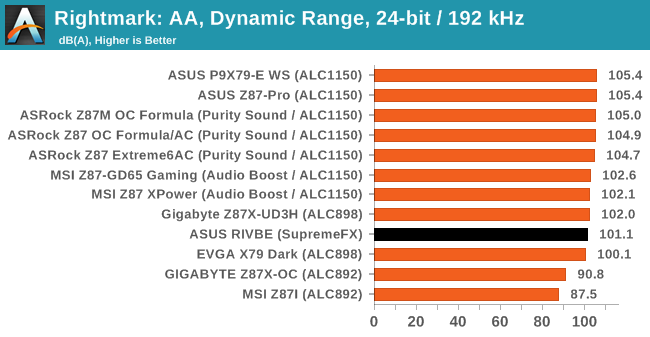
ASUS and I compared our SNR graphs to see the differences:
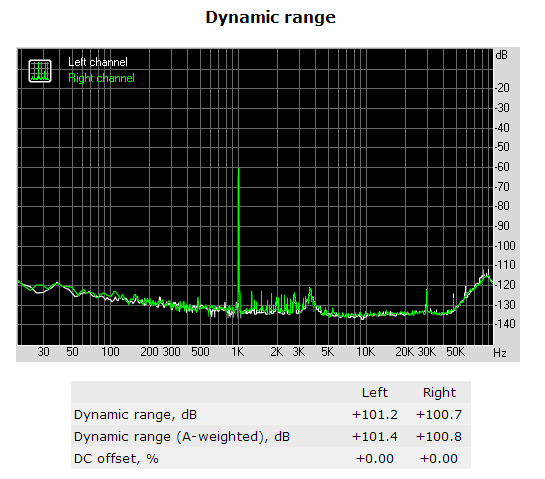
ASUS achieve a -108 dB SNR compared to my -101 dB SNR result due to ASUS using Audio Precision testing tools and my test using the Line In + RMAA methodology. The RMAA test also relies on a 1 kHz pulse at -60 dB for its test rather than a range of frequencies, which as a result causes the peak seen at 1 kHz.
In light of the discrepancy, we are coming to a fork in the road for audio testing. I fall wholeheartedly into the ‘tone deaf’ part of the crowd when it comes to analyzing audio and prefer an easy-to-read number as a comparison, although I understand this is not the be-all and end-all when it comes to audio. Ideally I would like to use Chris’ setup for future motherboard tests. I have asked Chris to perform testing on a few select models if he has time in the future, which might be in the works. But I do not have access to an AP testing setup, and my current solution sits with RM:AA. ASUS has offered to provide their results in future press packs, although independent verification is what we want to report. In light of motherboard development we may see other manufacturers doing it also. In order to improve our reporting in this area, I will in future publish the SNR graphs we receive from RM:AA for comparison.


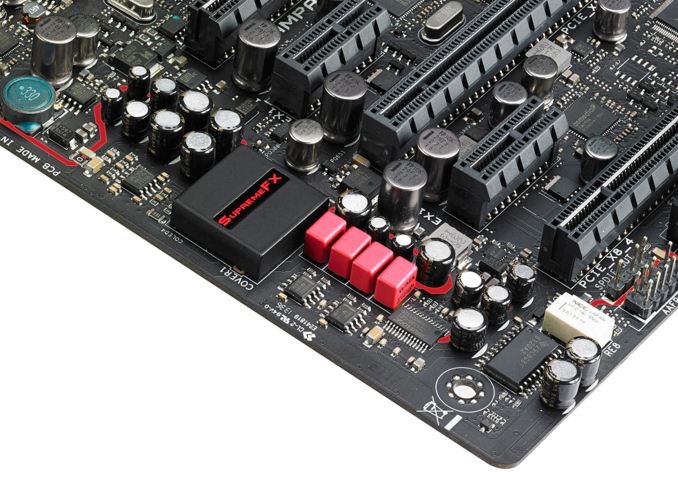
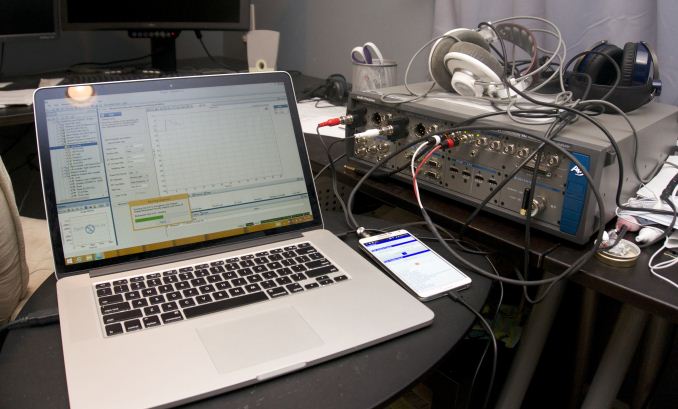

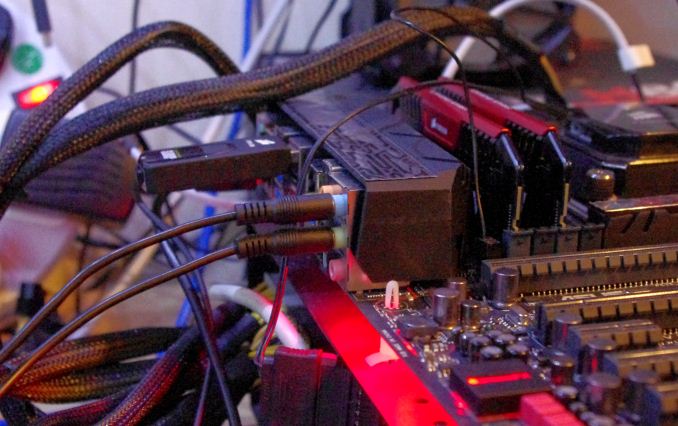
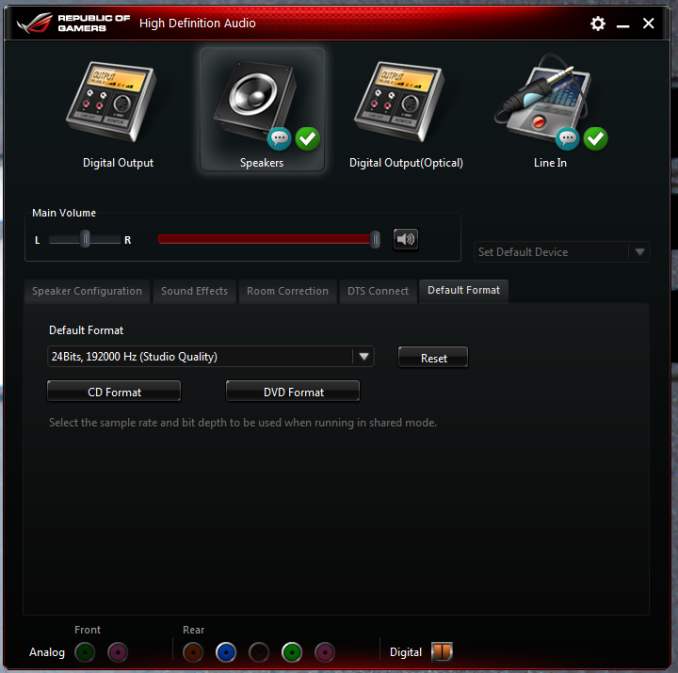








59 Comments
View All Comments
lever_age - Friday, January 31, 2014 - link
AP is certainly very respected, but they're not the only player in town. More so if you don't need super top-of-the-line performance and features.There's the dScope Series III and R&S UPV, off the top of my head, but those are relatively expensive as well. There are cheaper analyzers too, but I don't think it's particularly that worth it for a site like AnandTech.
One thing perhaps worth considering is still using RMAA but being more careful about actually physically measuring output levels for consistency and so on. Also, rather than loopback, you could record with a high-quality (and by this I mean a couple orders of magnitude less expensive than an AP analyzer) audio interface on another machine. To avoid ground loop issues, maybe a USB-powered interface running off a laptop off the mains. Or some external interface powered via isolation transformers. It's hard to get more legitimate noise results without some effort, anyhow.
slalomsk8er - Friday, January 31, 2014 - link
Please use an audio interface and test input and output of the motherboards separately.This will give a more consistent test environment. Please also test for the nagging noise that can creep in to the audio signal. On some Laptops it is so bad, that you can nearly count by ear the pixels the mouse is traveling ;)
vortexmak - Friday, January 31, 2014 - link
So how much of a difference is there actually between an audio solution like ALC1150 and an external DAC. Also which sound is better.. motherboard or smartphone ?jrs77 - Friday, January 31, 2014 - link
It's nice that you try, but I'd say: don't bother testing onboard-audio at all!The reason is pretty simple. The onboard-audio provides good enough sound for the genmeral crowd. Be it for watching movies, playing games or listening to MP3s and audio-streams.
Those who really listen to music or like to watch films in a hometheater-setup don't use a PC for playback to start with.
The best suggestion you can make to the majority of people is to use a cheap USB-DAC like the Behringer U202, which only costs some $20 and it'll drastically improve the sound, especially when more advanced headphones are used.
So yeah... don't bother testing onboard-audio, as you'll only get shout at by the audiioophiles while the majority isn't interested at all.
willis936 - Saturday, February 1, 2014 - link
On what grounds are you making the claim that a $20 USB DAC performs better than all, or even most onboard audio codecs? I'll want to see some graphs before I take a statement like that seriously.OoklaTheMok - Friday, January 31, 2014 - link
In this day and age, who really uses the analog outputs from a computer? A computer is an inherently nasty place for audio. There are plenty of clean digital output options such as SPDIF, USB, HDMI and DisplayPort.kwrzesien - Friday, January 31, 2014 - link
Maybe we need a survey of what users here are running? I have some good headphones and a Logitech 2.1 system on my desktop, both using rear analog audio on an old X58 board (Realtec something). If there is a $20 solution that would be better I'd like to know.jrs77 - Friday, January 31, 2014 - link
A Behringer U202 USB-DAC costs only $20, like I posted above.sheh - Saturday, February 1, 2014 - link
Would be nice if all amplifiers had some sort of digital input (other than SPDIF, which is limited).Impulses - Sunday, February 2, 2014 - link
My Xonar STX sounds just as accomplished and accurate as a lot of dedicated external amp/DAC solutions... Although I only got it for the value proposition as an all-in-one solution (headphone amp) and for Dolby Headphone.If you don't care for the latter then yeah, just go with a USB DAC if using headphones or HDMI/SPDIF if you have an AVR you like and a 5.1 setup (for stereo/2.1 a USB DAC is probably still the bettervalue tho, paired with something like a T-amp if on a budget).
I think most people who are critical of their audio will probably stay away from on board solutions for practical reasons as much as anything... It's hard to predict what you're gonna get with any given mobo, and if you have high end headphones or an AVR then it's kind of irrelevant either way. You're gonna need better amplification or you're gonna pass thru a digital signal.